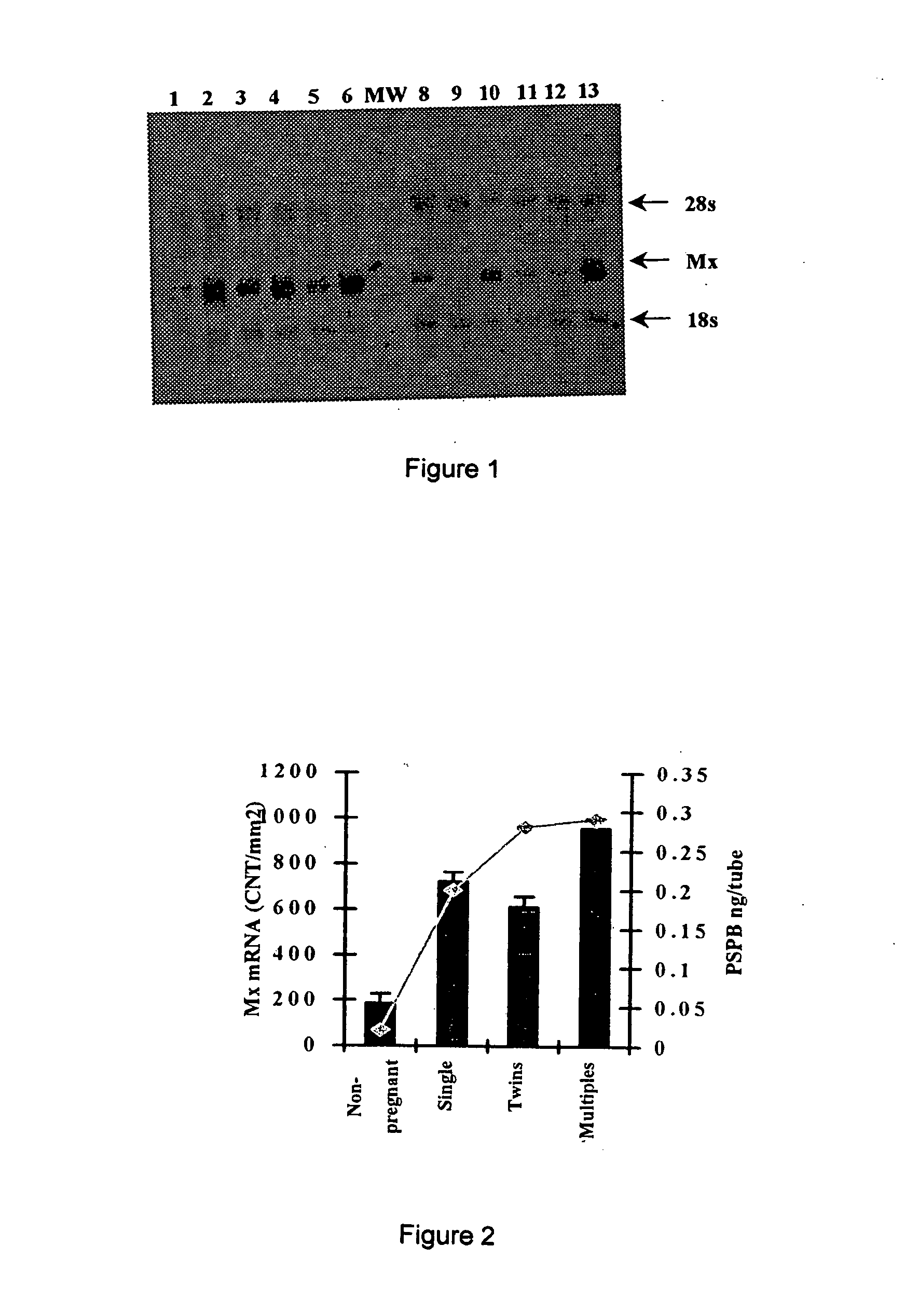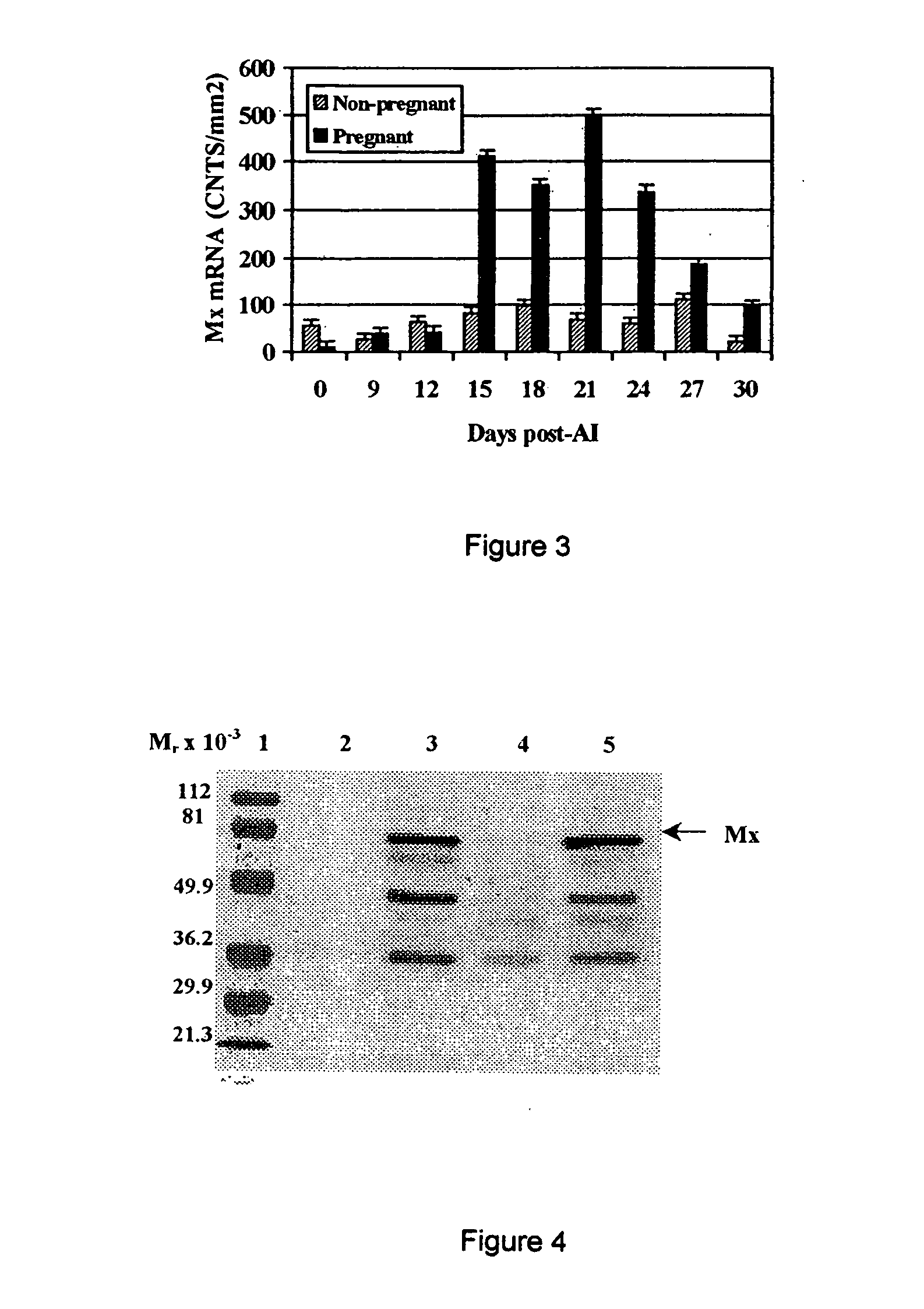Determination of pregnancy status
a technology for cows, applied in the field of determining the pregnancy status of animals, can solve the problems of not providing an accurate determination of pregnancy status, dairy cows, low fertility rate with artificial insemination,
- Summary
- Abstract
- Description
- Claims
- Application Information
AI Technical Summary
Benefits of technology
Problems solved by technology
Method used
Image
Examples
example 1
Animal Models
[0040] Sixty (60) mature, white-faced, ewes from the U.S. Sheep Experiment Station (USSES, Dubois ID) were synchronized and bred either by transcervical or laparoscopic artificial insemination (“AI”). Laparascopic AI was performed according the procedure disclosed in Stellflug et al., J. Anim. Sci. 79:568-573 (2001). The day of artificial insemination was designated Day 0 (D0) At 26 days after AI (D26), blood (10 ml) was collected by jugular venipuncture into EDTA-containing vacutainer tubes (Sherwood Medical, St. Louis Mo.). PBMC were isolated as described below in Example 2. Pregnancy was determined by assaying serum for pregnancy-specific protein B (PSPB; Biotracking Inc, Moscow ID) and lambing dates and number of lambs born were recorded.
example 2
PBMC Isolation
[0041] Blood was kept on ice until processed. Samples were centrifuged at 300×g for 20 min at 4 C. The buffy coat was removed and resuspended in 0.87% Tris-NH4CL lysis buffer at a 1 to 5 ratio. Samples were incubated for 5 min at 37° C. and centrifuged at 300×g for 10 min. The supernatant was removed and pellets were washed with 10 ml 1×PBS and centrifuged for 10 min at 300×g. After removal of supernatant, cell pellets were either frozen at −80° C. for protein extraction, or lysed with 2 ml TRIZOL (Life Technologies, Grand Island N.Y.) and stored at −80° C. for RNA extraction.
example 3
RNA Extraction, Northern and Slot-Blot Analysis
[0042] Total cellular RNA was extracted using TRIZOL according to manufacture's instructions. RNA was quantified by A260:280 ratio. To establish size and number of Mx transcripts in PBMC, RNA (5 μg) was electrophoresed in a 1% agarose / 0.615 M formaldehyde gel and transferred to a nylon membrane (Nytran, Schleicher & Schuell, Keene N.H.) by capillary blotting. For quantification of Mx mRNA levels in PBMC, RNA (5 μg) was transferred to a nylon membrane by vacuum filtration (Minifold II, Schleicher & Schuell, Keene N.H.). Blots were probed with a biotin-labeled ovine Mx anti-sense cRNA probe (Ott et al., Biol. Reprod. 59:784-794 (1998)) using the North2South Hybridization kit (Pierce, Rockford Ill.) and chemiluminescent signal was quantified using a Bio-Rad Fluor-S MultiImager system and Quantity One software (Bio-Rad, Hercules Calif.). Slot-blots were stripped and re-probed with an ovine 18s rRNA cRNA probe to correct for variations in R...
PUM
| Property | Measurement | Unit |
|---|---|---|
| time | aaaaa | aaaaa |
| time | aaaaa | aaaaa |
| Northern blot analysis | aaaaa | aaaaa |
Abstract
Description
Claims
Application Information
 Login to View More
Login to View More - R&D
- Intellectual Property
- Life Sciences
- Materials
- Tech Scout
- Unparalleled Data Quality
- Higher Quality Content
- 60% Fewer Hallucinations
Browse by: Latest US Patents, China's latest patents, Technical Efficacy Thesaurus, Application Domain, Technology Topic, Popular Technical Reports.
© 2025 PatSnap. All rights reserved.Legal|Privacy policy|Modern Slavery Act Transparency Statement|Sitemap|About US| Contact US: help@patsnap.com


